Easy Authentic Homemade Guacamole Recipe: Fresh, Flavorful & Fast
There’s nothing quite like the vibrant taste of fresh, homemade guacamole. This classic dip, a staple in Mexican cuisine, is incredibly simple to prepare, yet delivers an explosion of flavors that elevate any meal. Whether you’re enhancing your favorite tacos, piling it high on nachos, or looking for a healthy, satisfying snack, this recipe for authentic homemade guacamole is your ticket to a truly delicious experience. It’s naturally low-carb, gluten-free, and vegan, making it a perfect crowd-pleaser for parties, game nights, or a simple family dinner.
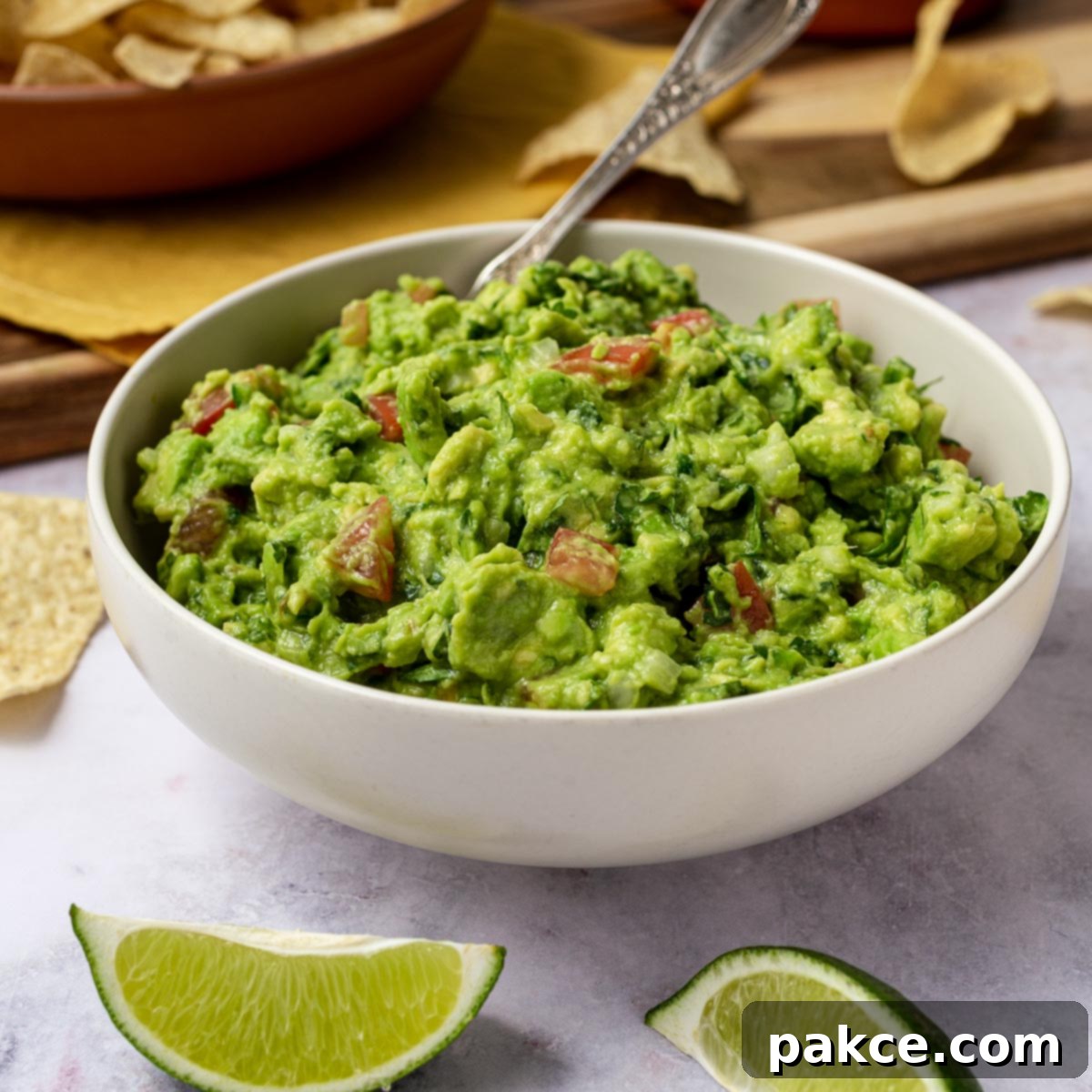
[feast_advanced_jump_to]
Why Make Guacamole from Scratch?
While store-bought options exist, nothing compares to the vibrant flavor and creamy texture of freshly made guacamole. Crafting it yourself allows you to control the quality of ingredients, adjust the seasoning to your exact preference, and ensure it’s free from unnecessary additives or preservatives. Plus, the process is incredibly quick and rewarding, turning fresh avocados and a few simple additions into a culinary masterpiece in minutes.
⏲️ Time Needed to Make Guacamole
One of the best aspects of this recipe is its speed. You can go from whole ingredients to a delightful bowl of guacamole in just **10-15 minutes**. This makes it an ideal last-minute appetizer or addition to any meal, proving that fresh and delicious doesn’t have to mean complicated or time-consuming.
❓ Homemade Guacamole FAQ
Absolutely, and you should! There is no need for any pre-packaged mixes or seasoning packets when making homemade guacamole. The beauty of this recipe lies in its simplicity and the use of fresh, high-quality ingredients that naturally provide all the incredible flavor you need. In fact, relying on fresh produce ensures a superior taste and texture that mixes simply cannot replicate. You’ll find that fresh avocados, combined with a few select aromatics and a touch of acid, create a far more authentic and delicious experience.
The core of a classic homemade guacamole includes a handful of essential fresh ingredients, each playing a crucial role in the final flavor profile:
- Avocados: The creamy base, rich in healthy fats and essential nutrients.
- Chopped Onion: Adds a sharp, pungent bite and depth of flavor. White or red onions are common choices, with red offering a slightly milder, sweeter taste.
- Chopped Tomato: Provides a burst of freshness, a hint of sweetness, and a lovely textural contrast. Make sure to remove the seeds to prevent excess moisture.
- Seeded and Diced Jalapeño Pepper: Delivers a gentle heat. For more spice, you can leave some of the seeds in or opt for a serrano pepper. For less, remove all seeds and veins.
- Salt: Crucial for seasoning and bringing out the natural flavors of the other ingredients. Always season to taste.
- Lime (Juice plus Zest): Adds a bright, zesty tang that cuts through the richness of the avocado and, importantly, helps prevent the guacamole from browning. The zest offers an extra layer of citrus aroma.
- Chopped Fresh Cilantro: Contributes a distinctive fresh, herbaceous note that is a hallmark of authentic guacamole. If you’re not a fan of cilantro, you can omit it or use fresh parsley as a very mild substitute, though the flavor profile will change.
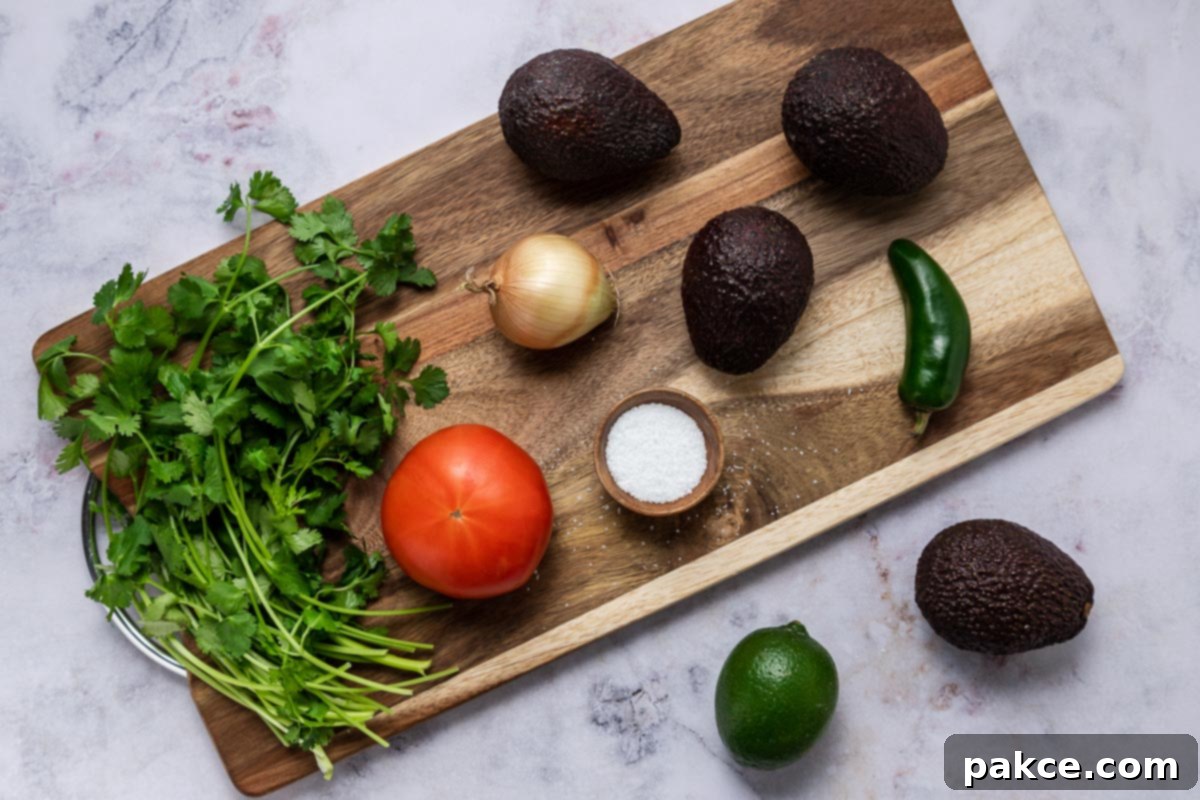
Making homemade guacamole is incredibly straightforward when you use fresh ingredients. The process involves selecting perfectly ripe avocados, carefully preparing them, and then gently mashing them with finely chopped onion, tomato, jalapeño, fresh lime juice, lime zest, salt, and cilantro. The key is to achieve a creamy texture with some desired chunks of avocado, rather than a completely smooth puree. Follow our detailed step-by-step instructions in the recipe card below, complete with helpful images, to guide you through each stage of preparation for a perfect batch every time.
Yes, this recipe adheres to the principles of authentic guacamole. True authentic guacamole relies on simple, fresh ingredients, avoiding any pre-made mixes or seasoning packets. The fundamental components are ripe avocados, onion, chili pepper (like jalapeño or serrano), cilantro, lime, and salt. While regional variations exist—some might include garlic, a different type of chili, or a splash of orange juice for sweetness—the core remains the same: fresh, simple, and flavorful. My preference is for onion over garlic, as I find it allows the avocado to shine more, but feel free to adjust to your personal taste!
Choosing the right avocado is paramount to great guacamole. Unripe avocados are hard and impossible to mash, while overripe ones can be stringy and brown. The trick is to find one that’s “just right.”
For immediate use, an avocado should be firm but yield slightly to a gentle squeeze in the palm of your hand. Avoid squeezing with your fingertips, as this can bruise the fruit. If it’s rock hard, it needs more time to ripen. If it feels mushy or has large soft spots, it’s likely overripe and may have brown areas inside.
I typically use Hass avocados, which are easily identifiable by their pebbly skin that darkens as they ripen. While color is a good indicator for Hass, other varieties may not change color significantly upon ripening, so always rely on the gentle squeeze test. The small stem cap can also offer a clue: if it comes off easily and reveals green flesh underneath, it’s generally ripe. If it’s hard to remove or reveals brown flesh, it might be overripe. You can certainly buy unripe avocados if you plan to use them a few days later, but attempting to use them before they are perfectly ripe will lead to disappointment.
If you find yourself with unripe avocados but need them sooner, there’s a simple trick to speed up the ripening process. Place the avocados in a paper bag and roll down the top to seal it. Store the bag at room temperature, away from direct sunlight. The paper bag traps ethylene gas, a natural ripening agent produced by the avocados, accelerating the process. Check them daily with a gentle palm squeeze; they usually ripen in just a few days this way. Avoid storing them in the refrigerator until they are ripe, as cold temperatures can halt the ripening process.
For the absolute best flavor and freshest appearance, I recommend preparing guacamole no more than an hour before you plan to serve it. The delicate avocado flesh is prone to oxidation, which causes it to turn brown. However, if you absolutely need to get a head start, you can prep all the ingredients *except* the avocados up to a day in advance. Chop your onions, tomatoes, jalapeños, and cilantro, and store them in separate airtight containers in the refrigerator. When you’re ready to serve, simply peel, pit, and mash the ripe avocados, then combine them with your prepped ingredients, add the lime juice and salt, and mix thoroughly. This method ensures your guacamole is as fresh as possible when served.
Homemade guacamole is truly at its peak quality within a couple of hours of preparation. Its vibrant green color and fresh taste begin to degrade relatively quickly due to oxidation. By the second day, even with careful storage, you’ll likely notice some browning and a slight separation of liquids. While it might still be safe to eat for another day if stored properly, the texture and flavor will not be as enjoyable as when freshly made. Aim to consume it within 24-48 hours for the best experience.
Preventing guacamole from browning is a common challenge, but it’s entirely possible with the right storage techniques that minimize exposure to oxygen. The key is to create an airtight seal over the surface of the guacamole. Here’s my preferred method:
- Press Out Air: Transfer your guacamole to an airtight container. Use a spoon or spatula to firmly press down on the guacamole, removing any air pockets along the surface and sides. This creates a compact layer.
- Smooth the Surface: Ensure the surface is as flat and smooth as possible, without any peaks or uneven spots where air could get trapped.
- Add a Protective Layer: Completely cover the surface of the guacamole with a thin layer of liquid. You can use water, fresh lime juice (which also adds flavor), or avocado oil. I personally prefer avocado oil as it doesn’t dilute the flavor and provides an excellent seal.
- Seal Tightly: Place the lid on your airtight container, ensuring it’s sealed snugly.
When you’re ready to enjoy it, simply pour off the protective liquid/oil (you can reserve it if you plan to store leftovers again) and stir the guacamole gently. If any slight browning has occurred on the very top layer, you can carefully scrape it off. Alternatively, placing plastic wrap directly onto the surface of the guacamole, ensuring no air bubbles, and then sealing the container, can also be effective. Vacuum sealing is another excellent method for preserving freshness, especially with tools like FoodSaver canning jar sealer attachments for canning jars (affiliate link).
While you technically *can* freeze guacamole, it’s generally not recommended for optimal quality. Freezing can significantly alter the texture of the avocado, making it mushy or watery upon thawing, and can also slightly degrade the fresh flavor. Guacamole is truly best enjoyed fresh, shortly after it’s made, when its creamy texture and vibrant taste are at their peak. If you have an abundance of ripe avocados, it’s better to make the guacamole and share it, rather than freezing it for later.
Yes, guacamole is an excellent choice for low-carb and keto diets! Avocados themselves are a fantastic source of healthy fats and very low in net carbohydrates. This particular homemade guacamole recipe, yielding 12 servings from 4 medium-sized avocados, contains approximately **2 net carbs per serving**. This makes it a perfect, flavorful addition to your keto or low-carb meal plan without derailing your macros.
If you’re avoiding traditional tortilla chips, there are plenty of delicious and healthy ways to enjoy guacamole! For low-carb alternatives, consider using:
- Low-carb tortillas: Cut them into wedges and bake or air fry until crispy.
- Toasted low-carb bread or crackers: A satisfying crunch with your creamy dip.
- Vegetable sticks: Carrots, celery, bell peppers, cucumber, and jicama are all fantastic for dipping.
- Lettuce wraps: Use large lettuce leaves (like butter lettuce or romaine) as a fresh, crunchy vessel.
- Cucumber slices: A refreshing and light option.
Guacamole also makes an incredible topping or side for various low-carb meals, such as Tex-Mex bowls, chili, grilled chicken, steak, or even as a creamy spread in sandwiches and wraps.
Guacamole is incredibly versatile and pairs well with a multitude of dishes. Here are some top serving suggestions:
- Classic Dippers: Of course, crispy tortilla chips and corn chips are always a favorite. For a low-carb option, baked wedges of low-carb tortillas work wonderfully.
- Mexican Main Dishes: It’s an indispensable topping for classics like tacos, tostadas, fajitas, and tortas. It adds a layer of richness and freshness that truly completes the meal.
- Eggs: Dollop it on scrambled eggs, omelets, or breakfast burritos for a delicious start to your day.
- Grilled Meats: Serve it alongside grilled chicken, steak, or fish for a healthy and flavorful accompaniment.
- Salads and Bowls: Use it as a creamy dressing or a topping for grain bowls, salad bowls, or even chili.
- Sandwiches and Wraps: Spread it inside your favorite sandwich or wrap instead of mayonnaise for a healthier, more flavorful twist.
No matter how you serve it, guacamole is sure to be a hit!
💭 Tips for Perfect Guacamole
- Jalapeño Handling: Always wear gloves when working with jalapeños (or any chili pepper) to protect your skin from the capsaicin oils. If you don’t have plastic gloves, clean grocery store produce bags can be reused effectively for this purpose. Remember to wash your hands thoroughly with soap and water afterward, especially before touching your face or eyes.
- Mashing Consistency: The perfect guacamole texture is a matter of personal preference. Some prefer it silky smooth, while others love distinct chunks of avocado. For this recipe, we recommend mashing gently, leaving some delightful chunks for added texture.
- Seasoning to Taste: Always taste and adjust seasonings. The amount of salt and lime juice needed can vary based on the ripeness and size of your avocados and your personal preference. Add a little at a time until it’s just right.
🥑 How to Cut and Peel an Avocado for Guacamole
Safely and efficiently cutting an avocado is key to getting to that creamy green flesh. Here’s a simple method:
- Halve Lengthwise: Place the avocado on a cutting board. Using a sharp knife, carefully cut it in half lengthwise around the pit. Rotate the avocado while holding the knife in place. If the avocado is ripe, the knife should slice through easily.
- Quarter the Halves & Remove Pit: Twist the two halves apart. Then, carefully cut each half lengthwise again, creating quarters. Gently twist the pit out with your fingers (or carefully tap your knife into the pit and twist to remove it).
- Peel: With ripe avocados, the skin should peel away fairly easily from each quarter. This method is safer than trying to scoop the flesh out with a spoon, especially if the avocado is very ripe.
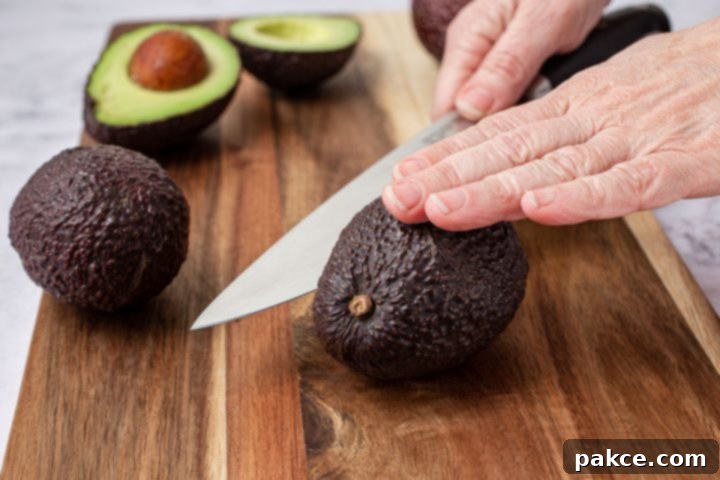
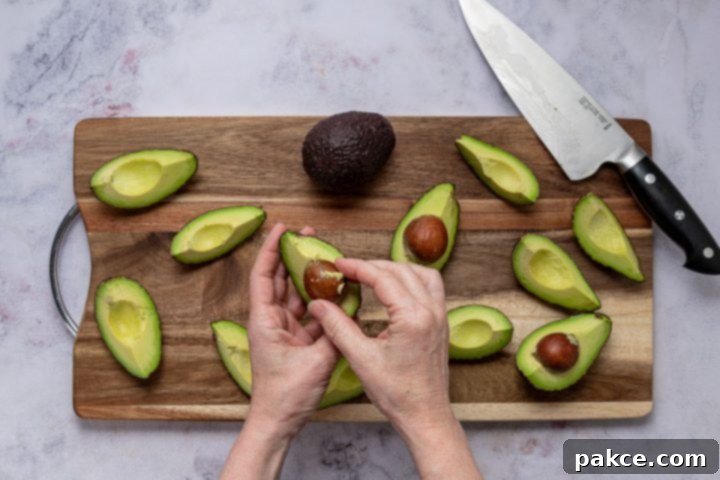
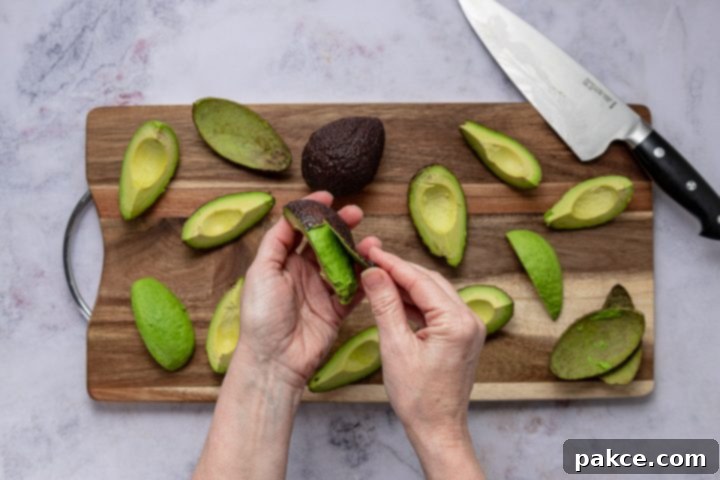
Recipe Card: Easy Homemade Guacamole
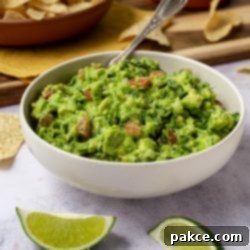
Easy Homemade Guacamole Step By Step
Add to Shopping ListGo to Shopping List
Ingredients
- 4 ripe avocados
- 1 small onion, chopped
- 1 medium tomato, chopped
- 1 jalapeno, seeded and chopped
- 1 teaspoon salt
- 2 tablespoons fresh lime juice
- ½ teaspoon lime zest
- ½ cup fresh cilantro, chopped
Instructions
-
Cut each avocado in half lengthwise, then cut in half lengthwise again. With each cut, take the knife all the way to the pit and, with the avocado on the cutting board and the knife horizontal and parallel to the cutting board, rotate the avocado carefully while holding the knife in place. If the avocado is ripe, it should be fairly easy to cut through.
-
Take the quarters apart and remove the pit by gently twisting with your fingers.
-
Peel each section of avocado.
-
Cube each avocado quarter, place in a medium bowl, and mash gently, leaving some chunks.
-
Add remaining guacamole ingredients and mix thoroughly.
-
Adjust seasonings to taste and serve immediately or refrigerate until ready to use.
Notes
Choosing avocados: For immediate use, avocados should be firm but have some give when you squeeze them gently in the palm of your hand. I usually buy the Hass variety, which turns darker as they ripen (other varieties may not darken with ripeness). The color of this variety in addition to the feel when you give them a gentle squeeze will help you determine the level of ripeness. If you end up with unripe fruit that you need to use, you can hasten ripening by putting them in a paper bag and rolling down the top. Leave them in the bag at room temperature until they ripen, checking them each day with a gentle squeeze.
Nutrition per serving
Share
Pin
💪 Health Benefits of Guacamole
Beyond its incredible taste, homemade guacamole offers a wealth of health benefits, making it a smart choice for a healthy diet:
- Rich in Healthy Fats: Avocados are packed with monounsaturated fatty acids, which are beneficial for heart health and can help lower bad cholesterol levels.
- Good Source of Fiber: Both avocados and other fresh vegetables in guacamole contribute dietary fiber, important for digestive health and promoting a feeling of fullness.
- Vitamins and Minerals: Avocados provide essential nutrients like Vitamin K, Vitamin C, Vitamin B6, Vitamin E, folate, and potassium. Lime juice adds more Vitamin C, while cilantro and tomatoes offer additional vitamins and antioxidants.
- Anti-inflammatory Properties: Many ingredients, including avocados, jalapeños, and cilantro, contain compounds with anti-inflammatory effects.
- Naturally Gluten-Free & Vegan: This recipe is suitable for a wide range of dietary needs and preferences.
- Low-Carb: As highlighted earlier, guacamole is an excellent choice for those following low-carb or ketogenic diets.
📌 Pin This Recipe for Later!
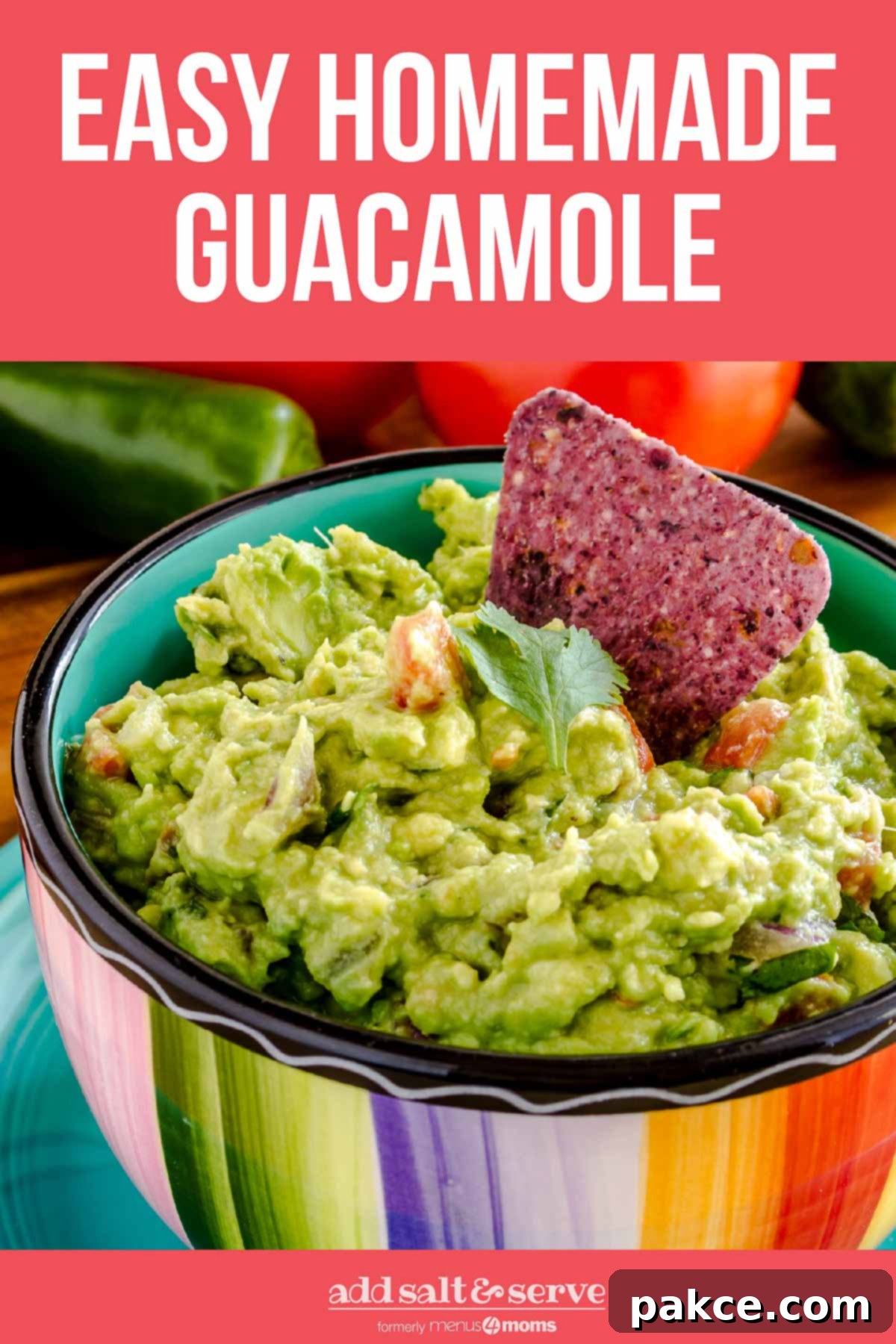
Conclusion: Embrace the Freshness of Homemade Guacamole
Making your own guacamole is a simple pleasure that rewards you with superior flavor, texture, and nutritional benefits compared to any store-bought alternative. With just a few fresh ingredients and minimal effort, you can create an authentic, vibrant dip that will be the highlight of any gathering or a healthy addition to your everyday meals. By following these tips and the easy recipe, you’ll master the art of homemade guacamole, ensuring perfectly ripe avocados and a rich, zesty, and satisfying dip every single time. So, grab your ingredients, get mashing, and enjoy the unparalleled taste of fresh, homemade goodness!